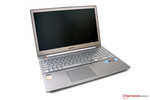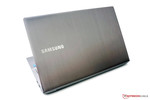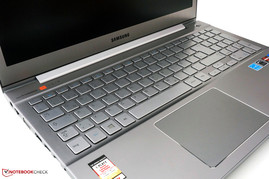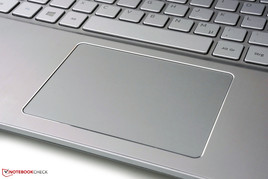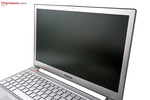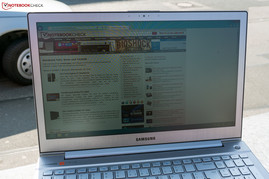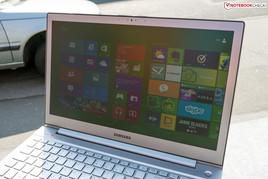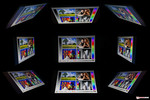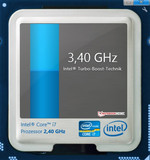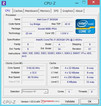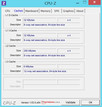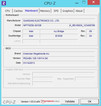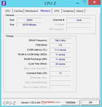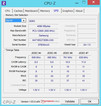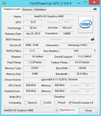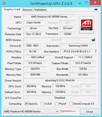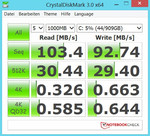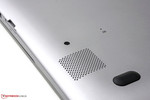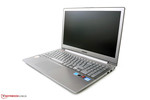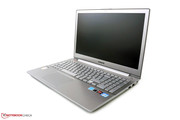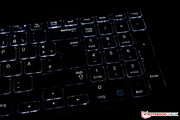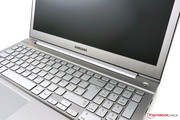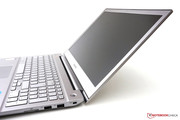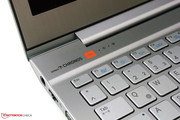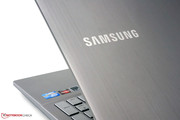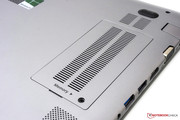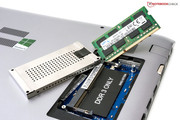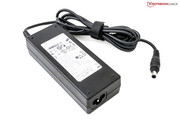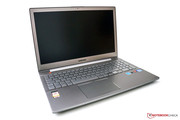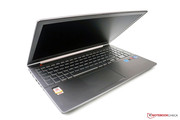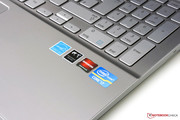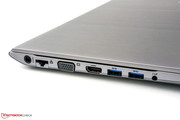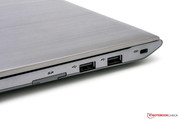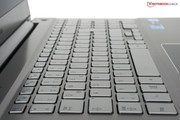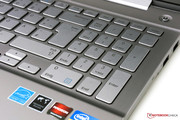Review Samsung Series 7 Chronos 770Z5E-S01DE Notebook

For the original German review, see here.
We have already tested the larger 17-inch 770Z7E-S01DE model of the Samsung Series 7 Chronos brand at length. Now, it's the little brother's turn, a 15.6-inch multimedia laptop which is supposed to be in no way inferior to its larger sibling. Build quality is great, as the Samsung Series 7 Chronos 770Z5E-S01DE is wrapped into a slim metal case with a premium feel. It definitely stands out of the crowd when compared to other multimedia laptops, but with a recommended retail price (RRP) of $1700 it is no cheap buy.
One of its most important features is the matte 15.6-inch display with a Full HD 1080p resolution of 1920x1080 pixels. Samsung promises 300 nits of brightness for the screen. The 770Z7E's inner specs are every bit as impressive. The laptop is driven by an Intel Core i7-3635QM quad-core processor with a base clock speed of 2.4 GHz. It comes equipped with a dedicated GPU with 2 GB of GDDR5 memory - the AMD Radeon HD 8870M - 8 GB of DDR3 memory and a 2.5-inch HDD capable of storing 1 TB of data. So far, Samsung doesn't offer an SSD variant. Windows 8 (64-bit) was pre-installed on our test device whereas the model 770Z5E-S02DE comes with Windows 8 Professional.
No other variants of Samsung's newest 15.6-inch Series 7 Chronos are available. It would have been nice to see some more variety - like Samsung chose to do with the 17-inch model (more about that later). Still, the 770Z5E-S01DE is a very interesting notebook which will have to prove itself in the following review.
During unpacking, we are immediately greeted by a well-designed laptop. Samsung has put some effort into a more modern look when compared to the 700Z5C. The display lid, the frame around the screen and the inner surfaces next to its keyboard are made from brushed aluminum. Our first impression is quite favorable, both optically as well as haptically. Then again, the underside consists of mere plastic, but at least it is fingerprint-proof due to its matte surfaces. Dust and dirt are also rather unobtrusive because of its silverish color. Generally speaking, there is no room for criticism concerning its build quality when compared to its larger sibling. Everything has been processed with care and the gaps between the different components are very even.
Stability is decent. The base units sags only when considerable pressure is applied, something which doesn't happen during real life usage. The display lid can be skewed despite its aluminum layer and some cracking can be heard as soon as too much force is exerted. Still, no distortions occur on the screen itself. The centered display hinge holds the display lid firmly in place, but it can still be opened with just one hand. The maximum opening angle of 135 degrees should be enough for most users. One disadvantage lies with a visible bobbing of the display due to its sheer weight.
Due to its high-quality build and the materials used, the Samsung 770Z5E is able to secure a place in the upper third of all multimedia notebooks. However, it does not reach the near-perfection levels of an Apple MacBook Pro 15 Retina. The Samsung laptop weighs 2.37 kilograms while measuring 376 x 250 x 21 millimeters (W x D x H), thus being noticeably heavier and thicker than its 2.03-kilogram competitor from Apple. Cheaper devices like the Asus VivoBook S550CM-CJ038H tend to be heavier at 2.63 kilograms and even the newer Asus N56VB-S4050H weighs 2.68 kilograms. When compared to its bigger brother, the 17-inch Samsung Series 7 Chronos 770Z7E-S01DE (3 kilograms including its battery), the 770Z5E remains 600 grams lighter.
A lot has changed back and forth during the various design phases, especially around the sides of the case. This becomes clear in comparison with the 700Z5C and the 700Z5A from 2011. For example, no optical drive remains. Instead, a full-sized VGA port and four USB ports (2x USB 3.0 & 2x USB 2.0) are on board. These are complemented by an RJ-45 Ethernet port, a card reader, the HDMI output and a Kensington lock which has moved to the right hand side of the laptop (together with the 4-in-1 card reader). All in all, this is quite a variety considering the laptop's size and slimness.
Port positions as well as their distribution are thought-out. The front third on both sides remains unused, which is a favorable design choice from an ergonomics standpoint (e.g. when an external mouse is connected). Also, the most-used ports are located on the left side which is nice for right-handers (and not so nice for left-handers).
Communication
Nothing is missing here. The Realtek PCIe GBE Family Controller supports data transfer rates of up to 1 Gbit/s. Bluetooth as well as Wi-Fi is handled by an Intel module, the Intel Centrino Advanced-N 6235, which supports Bluetooth 4.0 and Wi-Fi 802.11a/b/g/n (2.4 and 5 GHz with up to 300 Mbit/s). Only the new 802.11ac standard with a maximal bandwidth of 1.3 Gbit/s at 5 GHz is not supported. The 770Z5E is capable of driving remote displays via WiDi (Wireless Display).
The modem shows an average performance. Full Wi-Fi signal strength can be upheld within the apartment and within a radius of around 10 meters. One floor below as well as 30 meters away, only 50% is possible, while the signal continues to get weaker if the distance is increased any further.
Accessories
No surprises here - apart from the laptop itself, only the 90 watt power adapter (125 x 50 x 30 millimeters) plus a number of printed manuals can be found within the package. There is no driver or recovery DVD. Any system recovery is done via a dedicated program, which comes preinstalled and which can be used to create a corresponding image.
Maintenance
Both maintenance and upgrades are not made easy by Samsung. There is only a small maintenance hatch to be found on the underside. A single DDR3 memory bank sits beneath, which comes equipped with a 4 GB module while the other 4 GB is soldered onto the motherboard. More than 12 GB RAM is thus impossible. All other components can only be accessed if one chooses to disassemble the base unit. This is not to be taken lightly due to the inherent danger of damaging the laptop, since it is not sufficient to untighten a few screws. Everything is firmly attached using delicate plastic hooks (as is the case with many other ultrabooks). Accordingly, we cannot be made responsible for any damage caused by attempting to disassemble the base unit.
Warranty
Samsung offers 24 months of warranty. In addition, it is possible to activate a warranty extension (up to 36 or 48 months) within the first 90 days after the purchase. This includes an on-site pickup service.
Keyboard
There is no difference between the keyboard used in the 770Z5E and that in its larger sibling, the 770Z7E apart from a nice silver finish to the keys which is absent in the 17-inch 770Z7E-S01DE and which helps to make the 770Z5E's optical impression more well-rounded. We are still impressed by the generous palm rest, the well-defined pressure point and the feeling of our keystrokes. Thanks to its quietness and a separate numpad on the right side, the keyboard should be suitable for heavy users. In addition, the keyboard is backlit. The white light can be controlled via the Fn keys, allowing the user to choose between four different steps (as can be seen in the picture below). During the day, an ambient light sensor prevents the keyboard illumination from turning on.
Touchpad
The touchpad is another old friend with new livery. The Elan Smart-Pad has been sunk a little bit into the case and now sports a glossy frame. It offers a lot of space (107 x 77 millimeters), well-implemented multitouch gestures and a mature software solution. A slightly coarse surface layer guarantees favorable gliding characteristics. The mouse buttons are integrated into the touchpad. While the entire surface can be used for a left-click, right-clicking is only possible in the lower right-hand corner or via a gesture. The detailed software with its video explanations is worth a closer look.
How could laptops with a premium claim such as the Series 7 Chronos devices fail to deliver an appropriate display? That's why Samsung chooses to include a matte 15.6-inch Full HD display with 1920x1080 pixels. This is not only a great resolution for gamers, but also for video playback and desktop use due to the increased screen real estate. As can be found out easily via a number of tools, Samsung uses a TN-panel of the type AU9003, thus refraining from a home-made solution. No alternatives - neither RGB displays nor IPS panels - are offered, but of course, external displays can be connected via HDMI, VGA or even Wireless Display.
Starting with a screen brightness measurement using the i1Pro 2 tool by X-Rite, the AUO panel achieves an average of 274 cd/m², which is more than both the 17-inch 770Z7E-S01DE and its predecessor, the 700Z5C, offer, yet slightly less than Samsung's statement of 300 nits (a deviation of less than 10% is still within our tolerances). Illumination homogeneity is on par with most other screens, yielding a decent value of 85%. The Apple MacBook Pro 15 with Retina-Display fares approximately the same in this regard.
| |||||||||||||||||||||||||
Brightness Distribution: 85 %
Center on Battery: 300 cd/m²
Contrast: 1435:1 (Black: 0.2 cd/m²)
66.1% AdobeRGB 1998 (Argyll 3D)
90.9% sRGB (Argyll 3D)
65.7% Display P3 (Argyll 3D)
All other tests end quite satisfying. Blacks are indeed black, with levels of 0.2 cd/m², yielding a great contrast ratio in combination with the 770Z5E's maximal brightness levels. This actually beats the MacBook Pro 15 with Retina Display, although the latter sports superior display technology. It is also much better than the 700Z5C, which had a black level value of 1.81 cd/m².
Professional users beware: Color space reproduction is a very important aspect especially for photographers. While the SEC0006 panel used in the 700Z5C was not much more than a consumer product, its successor plays in the same league as the MacBook Pro 15 with Retina Display, which performs ever so slightly better. Still, the reference sRGB and AdobeRGB color spaces cannot be depicted fully.
CalMAN software measurements reveal some slight color miscalibration which should barely be visible with the naked eye. Blues are a bit overemphasized within the RGB balance, yielding a slightly cool impression. This is not meant as a point of criticism, since it is just a tiny difference. Subjectively, color rendition and image sharpness are very persuasive.
A matte display in combination with good test results offers a very good chance of it being usable outdoors. While the ambient light sensor is illuminated, the center point of the display reaches up to 300 cd/m². Even under a clear sky and strong sunlight, the screen contents remain visible (although brightness adaptation should be deactivated in the settings). This is an impressive feat. Only with the sun shining from behind or another strong light source does the screen reach its limits, forcing us to move around a bit.
Last but not least, viewing angle stability is another important factor. We are quite surprised by the AUO TN panel - both horizontally and vertically, the results are quite satisfying. The colors are never truly inverted which means that the 770Z5E-S01DE does not have to hide from its theoretically superior IPS competitors.
We are glad that Samsung chose to use the same hardware in the 770Z5E as in the 770Z7E-S01DE, refraining from a down-scaling. The laptop is driven by an Intel Core i7-3635QM quad-core processor with a base clock speed of 2.4 GHz, an Ivy Bridge chip with 3D transistors which are manufactured using a 22 nanometer process. It also sports 6 MB L3 cache and a turbo boost of up to 3.4 GHz when only one core is used. When compared to the i7-3630QM, the Intel GMA HD 4000 used in the i7-3635QM clocks at 1200 MHz instead of 1150 MHz. In addition, the new visualization technique VT-d is supported.
Next to the integrated graphics core, the laptop also ships with a dedicated GPU, an AMD Radeon HD 8870M with a clock speed of up to 775 MHz which is manufactured using a 28 nanometer process while offering 2 GB of GDDR5 memory clocked at 1125 MHz. More precise details concerning this GPU can be found within our detailed review of the 770Z7E-S01DE. Switching between both devices is handled automatically via a technique called Enduro, which is comparable to Nvidia's Optimus.
The laptop is also equipped with 8 GB RAM (DDR3, clocking at 1600 MHz) and a 1 TB 2.5-inch hard drive, which is very difficult to remove from the laptop without damaging its case. Memory modules, however, can be replaced within a few minutes. Up to 12 GB RAM is possible.
Throttling
Our first tests were concerned with the behavior of both the CPU and the GPU under full load. No problems occurred when only the processor was strained using the Prime95 benchmark - the system is constantly working in turbo boost mode with all four cores reaching 3.2 GHz. Similar results can be found when just the AMD Radeon HD 8870M is active. Furmark runs smoothly with the GPU working at 725 to 775 MHz (with a stable memory clock speed of 1125 MHz), exhibiting none of the problems which often arise a few minutes into the stress test.
The full stress test - using both the Prime95 benchmark as well as Furmark - is more interesting. The larger 770Z7E-S01DE had problems keeping up to the full CPU clock speed. Not so the Samsung Series 7 Chronos 770Z5E-S01DE. Only the turbo boost gets deactivated once the laptop runs too hot. Still, clock speeds never fall below their 2.4 GHz base value so that throttling is no issue for the 770Z5E.
Right after our stress test, we started 3DMark 06. The Samsung laptop manages to cool down quickly, thus yielding the same results as after a cold start. Even an elaborate 3D game was not enough to limit its turbo boost. We are therefore very confident that performance issues due to throttling are highly unlikely during daily usage.
Processor
The Cinebench R11.5 results of the Intel Core i7-3635QM boil down to 6.38 points during the multi-thread calculation (64-bit), placing it slightly above the Intel Core i7-3630QM with a base clock speed of 2.3 GHz (e.g. the HP Envy dv6-7202eg with 6.26 points). Devices with an Intel Core i7-3720QM quad-core processor offer a better performance, like the Schenker XMG P702 Pro with 6.6 points, a difference of just 3%. Thus, the Intel Core i7-3635QM takes a place in the upper third of all processors we have tested so far.
The same holds true for the single-core calculations using the same tool. 1.39 points is 2% higher than the result of the i7-3610QM and 5% below that of the i7-3720QM (which clocks at 200 MHz more).
| Cinebench R11.5 - CPU Multi 64Bit (sort by value) | |
| Samsung 770Z5E-S01DE | |
| HP Envy dv6-7202eg | |
| Schenker XMG P702 PRO | |
System Performance
We measured the performance of our test system via Futuremark's PCMark 7, yielding 3970 points, which is an above average result. An even better rating for the 770Z5E-S01DE near the top of our list was prevented by the 2.5-inch Seagate HDD - in our experience, faster SSDs can have a significant influence on the PCMark results.
A good example would be the Asus Zenbook Prime UX31A with a ULV processor and a solid state drive. Its 5155 points is approximately 30% more than what the 770Z5E accomplishes. Still, in real life usage it's hard not to be content with the system performance of the 770Z5E-S01DE. Loading times are tolerable and work-related applications pose no problems due to the 770Z5E's potent hardware.
| PCMark 7 Score | 3970 points | |
Help | ||
Storage Devices
Samsung relies on a 2.5-inch hard drive storage solution made by Seagate, more specifically, a Momentus SpinPoint M8 ST1000LM024 HN-M101MBB (construction height: 9.5 millimeters) which spins at 5400 revolutions per minute. Its performance is alright, but nothing to write home about, with sequential data transfer rates of around 100 MB/s.
A solid state drive (SSD) would do much to boost the 770Z5E's performance by a noticeable factor. Hard drive access times averaging around 10 to 18 milliseconds are its bottleneck, while access times of an SSD hover around 0.2 milliseconds. Unfortunately, this is exactly where the 15.6-inch laptop differs from the larger 770Z7E: Samsung does not offer any SSD configurations. Additionally, a later upgrade is hampered by the bad accessibility of the 770Z5E's innards.
Graphics Card
Prior to our actual PC gaming tests, the AMD Radeon HD 8870M is forced to prove itself within Futuremark's synthetic gaming benchmarks. DirectX 11 performance as tested with 3DMark 11 is more than just decent, yielding 2996 points during the GPU benchmark (performance mode). This is more than the 2820 points of the MSI GT60-i789W7H, a representative of the Nvidia GeForce GTX 670M family which is based on the slightly older Fermi architecture. Newer graphic cards like the GeForce GT 650M or the GeForce GTX 660M also fare worse than the HD 8870M, being forced to admit defeat by approximately 20 to 30%.
These encouraging results are fostered by the Fire Strike GPU benchmarks within 3DMark (2013), with the AMD Radeon HD 8870M reaching a laudable result of 2168 points. The Nvidia GeForce GTX 660M used by Schenker's XMG P502 only manages to get 1751 points, 19% less, while the weaker GeForce GT 650M (with which the Asus N76VZ-V2G-T1011V ships) doesn't manage to exceed 1231 points, down by a stark 43%.
| 3DMark 11 - 1280x720 Performance GPU (sort by value) | |
| Samsung 770Z5E-S01DE | |
| Samsung 770Z5E-S01DE | |
| MSI GT60-i789W7H | |
| Schenker XMG A522 | |
| Asus N76VZ-V2G-T1011V | |
| 3DMark 05 Standard | 18829 points | |
| 3DMark 06 Standard Score | 15785 points | |
| 3DMark Vantage P Result | 11840 points | |
| 3DMark 11 Performance | 3311 points | |
| 3DMark Ice Storm Standard Score | 50756 points | |
| 3DMark Cloud Gate Standard Score | 11402 points | |
| 3DMark Fire Strike Score | 2091 points | |
| 3DMark Fire Strike Extreme Score | 1036 points | |
Help | ||
Gaming Performance
Taking a glance at the actual gaming performance of the AMD Radeon HD 8870M, our positive impression is consolidated, albeit with a few exceptions due to excessive variations in our real-life results. One of the reasons lies with AMD's drivers which are not as capable as Nvidia's Optimus solution in gaining extra performance due to lower quality settings.
Most recent games can only be played with noticeable limitations if maximum graphics quality and a resolution of 1920x1080 pixels are chosen. A good example of this is BioShock Infinite, which offers an integrated benchmark. 19.3 fps on Full HD with the "ultra preset" stutters too much in order to remain playable. However, with high quality settings and a resolution of 1366x768 pixels, 51.4 fps is reached, making sure that the game runs smoothly at all times.
Thus, the 770Z5E seems like the perfect solution for casual gamers who are not always hell-bent on top-notch graphics quality. Even the most recent games can be played on lower resolutions and with reduced details while more modest titles such as FIFA 13, Diablo III or Counter Strike: Global Offensive actually run smoothly and without limitations even at the native resolution of 1920x1080 pixels.
| low | med. | high | ultra | |
|---|---|---|---|---|
| World in Conflict - Benchmark (2007) | 134 | 58 | 48 | 32 |
| Mafia 2 (2010) | 80.4 | 72.4 | 65.1 | 43.1 |
| Battlefield 3 (2011) | 51.5 | 41.4 | 40.8 | 19.9 |
| Alan Wake (2012) | 70.9 | 48.6 | 23.1 | |
| Mass Effect 3 (2012) | 60 | 60 | 47.8 | |
| Dirt Showdown (2012) | 67.9 | 48.6 | 35.7 | 24.6 |
| Sleeping Dogs (2012) | 50 | 34.5 | 28.8 | 12.1 |
| Fifa 13 (2012) | 243.7 | 186.2 | 166 | 131.2 |
| Medal of Honor: Warfighter (2012) | 78.3 | 63.1 | 49.9 | 20.1 |
| Need for Speed: Most Wanted (2012) | 55.9 | 47.6 | 37.1 | 26.1 |
| Crysis 3 (2013) | 58.8 | 39.2 | 26.5 | 10.8 |
| Tomb Raider (2013) | 123.3 | 80.4 | 55.3 | 25.5 |
| SimCity (2013) | 83.3 | 47.8 | 37.5 | 20.3 |
| StarCraft II: Heart of the Swarm (2013) | 194 | 85.2 | 68.5 | 25.9 |
| BioShock Infinite (2013) | 70.3 | 55.7 | 51.4 | 19.3 |
System Noise
In comparison with the 700Z5C, Samsung has managed to reduce noise emissions during office usage. With up to 30.6 dB(A) from a distance of 15 centimeters, the notebook stays very silent and rarely makes itself perceptible. During silent mode, the laptop remains (almost) noiseless since the fan is deactivated. Only a quiet whooshing of the hard drive can be heard, but even this is just background noise with levels of around 31.4 dB(A). However, if the notebook was fitted with an SSD, no noise at all would be produced.
Noise under full load doesn't exceed 39.2 dB(A). Even in this scenario, our test device remains quieter than its predecessor and thus ends up being on par with most devices which offer similar features for a similar price. Still, it is definitely audible and the noise it makes comes with an annoying high-pitched buzzing sound.
Noise level
| Idle |
| 30 / 30.6 / 30.6 dB(A) |
| HDD |
| 31.4 dB(A) |
| Load |
| 32.3 / 39.2 dB(A) |
 | ||
30 dB silent 40 dB(A) audible 50 dB(A) loud |
||
min: | ||
Temperature
The 770Z7E-S01DE's powerful hardware now has to get rid of its excess heat in the smaller frame of a 15.6-inch device. Like with its larger sibling, no universal conclusion can be drawn. While idle, all crucial surfaces remain fairly cool. After one hour of our stress test, however, the underside had heated up to around 42 °C, while the immediate vicinity of the keyboard fared even worse with 50 °C. During real-life usage, this effect is not quite as pronounced, with the laptop reaching only moderate temperatures of up to 33.6 °C. The cool aluminum surfaces help with keeping the subjective temperatures between cool and lukewarm.
Luckily, the keys protrude a little bit, keeping them a bit cooler than the base unit a few millimeters beneath. Actual usage rarely causes strains such as those of our stress test, with Furmark (GPU) and Prime95 (CPU) running at the same time. Details concerning throttling issues can be found a bit further up in this article where we analyzed the laptop's performance.
(-) The maximum temperature on the upper side is 50 °C / 122 F, compared to the average of 36.9 °C / 98 F, ranging from 21.1 to 71 °C for the class Multimedia.
(±) The bottom heats up to a maximum of 42 °C / 108 F, compared to the average of 39.2 °C / 103 F
(+) In idle usage, the average temperature for the upper side is 28.8 °C / 84 F, compared to the device average of 31.3 °C / 88 F.
(+) The palmrests and touchpad are cooler than skin temperature with a maximum of 31.5 °C / 88.7 F and are therefore cool to the touch.
(-) The average temperature of the palmrest area of similar devices was 28.7 °C / 83.7 F (-2.8 °C / -5 F).
Speakers
The laptop uses a 2.0 stereo system made by JBL to render audio. Both speakers have 4 watts at their disposal. Overall sound quality is very good, so that obviously the resonance chamber is large enough despite the 770Z5E's slim profile. Even positioning the speakers underneath the device didn't have any negative consequences, so that we definitely do not have to advise potential buyers to look for an external solution. For most purposes, the integrated speakers of the 770Z5E should be more than adequate.
Of course, it is still possible to plug in a headset, external speakers or an AV receiver via the 3.5 mm Line In/Out or the HDMI port. Transmission quality is great - the resulting sound experience only depends on the peripheral equipment.
Power Consumption
Thanks to its modern components, the Samsung laptop doesn't use too much power despite its more than decent performance. 8.6 to 14.9 watts can be expected during office tasks. This is just slightly above the power consumption levels of modern ultrabooks with a ULV processor and an integrated graphics unit.
Power consumption increases strongly under full load, with stress test (Furmark + Prime95) values of up to 88.5 watts, which is still below the threshold of what the power adapter can supply (the larger 770Z7E-S01DE crosses this threshold of 90 watts). In total, power consumption levels are still acceptable.
The 91 Wh battery is permanently installed, but at least well-dimensioned. It provides the basis for decent battery life values, which we will analyze in the following section.
| Off / Standby | |
| Idle | |
| Load |
|
Key:
min: | |
Battery Runtime
The Battery Eater Reader's Test simulates reading a text document on minimal screen brightness while being in airplane mode. Thanks to its large battery, the 770Z5E manages to stay alive for up to 15 hours and 45 minutes, while the larger 770Z7E-S01DE and the 700Z5C with its smaller battery barely scratch the 10-hour mark. Only the Apple MacBook Pro 15 with Retina Display fares better with almost 18 hours. A negative example would be the Asus N56VB-S4050H with just 5 hours of reading time.
The other extreme can be examined while under full load. We use the Battery Eater Classic Test, while activating all radio modems and turning the laptop's screen brightness way up. The 770Z5E manages to squeeze 1 hours and 53 minutes out of its battery, approximately the same as its predecessor, the 700Z5C. The Samsung Series 7 Chronos 770Z7E-S01DE (66 minutes), the Apple MacBook Pro 15 with Retina Display (88 minutes) and the Asus N56VB-S4050H (58 minutes) all perform worse.
A realistic estimate can be gained through our "surfing on Wi-Fi" measurement, where a script opens a new website every 40 seconds. Screen brightness is set to a standardized 150 cd/m² in order to create reproducible as well as comparable conditions. We measure 10 hours and 42 minutes for the 770Z5E. This is a very satisfying result, exceeding the runtimes of all other laptops mentioned above. Our overall impression of the 770Z5E's battery life is therefore quite favorable.
The Samsung Series 7 Chronos 770Z5E-S01DE is not only a successful advancement over its predecessors, but also a recommendable laptop in its own right, despite its high price tag of around $1500. Its chassis looks and feels premium and its input devices are outstanding. Plus, it is equipped with all kinds of ports and radios. Then there is the matte 15.6-inch Full HD display which has made a good impression on us despite using a TN panel.
Our main concern lies with its barely reachable innards. The hard drive and the integrated battery cannot be accessed by the user - only its RAM can be upgraded through a small maintenance hatch. This issue makes it even more crucial to offer a wider range of different hardware configurations, especially variants with an SSD instead of a conventional hard drive, but none exist. However, both application and graphics performance were convincing. Even some casual gaming was possible thanks to the 770Z5E's combination of an Intel Core i7-3635QM and an AMD Radeon HD 8870M. Still, this is not a gamer's device.
The Samsung Series 7 Chronos 770Z5E was also capable of winning us over with its low emission levels. There is even a great 2.0 JBL sound system. We cannot complain about power consumption and battery life, either. The 770ZE5 manages to achieve a good balance between maximum performance and good battery life during less demanding tasks, e.g. office usage.





